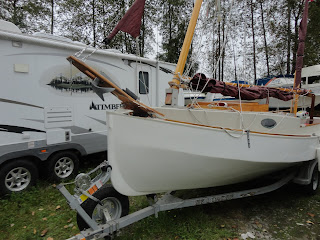Cal Cran is a Chebacco builder/sailor from Alberta who got together with legendary Chebacco builder/sailor Jamie Orr with Wayward Lass from for a fall cruise in Howe Sound. They were joined by Curtis Patzer sailing his Siren 17, Nautilus. The following is Cal's report of the cruise with some photos courtesy of Jamie. Thank you both for sharing!
Yaviza my Chebacco cat yawl had not been
away from Mabel Lake for 2 years so during the last week of September I checked
the weather forecast for Howe Sound, found the conditions were to be excellent
and hatched a plan to drive out and sail for 4 or 5 days.
Emails were sent out to Jamie Orr, Curtis
Patzer and Randy Wheating. All replied and agreed to try and meet up, except
for Randy as he was in France.
I arrived in North Van. At Sunset Marina
Wednesday afternoon and rigged the boat for a morning departure. Cooked supper
at the marina in the parking lot and slept in the boat.
Thursday morning was pure blue skies and
calm winds so after a leisurely breakfast motored out of the marina towards
Gibsons which I estimated as 4 to 5 hours away, where I was to met Jamie near
Plumpers Cove marine park. Jamie was crossing the Georgia Strait from Crofton,
Vancouver Island. The meeting went perfectly to plan, as I arrived at the same
time as Jamie! I motored for about 3 hours before the wind came up and allowed
sailing. This motoring time gave me time to play with my new 5 watt solar panel
and charge the 18amh battery I had just installed. This system powers a LED
cabin and anchor light that I just bought from Bebi Electronics in Fiji, it has
enough power to power the lights, GPS and handheld VHS for at least 3 days
without the sun.
Plumpers Cove was not collecting fees as it
was the end of the season so we tied up to the dock for the night.
Next morning a light breeze was blowing so
we played around in Shoal Channel before going into Gibsons for a second
Breakfast at Mollies Reach. After breakfast it started to rain lightly so
donned the rain gear and set sail for a trip around Bowen Island through
Collingwood Channel , the rain turned to real rain and the wind was 10 knots
from the NW which made for a nice reach into the channel!, once in Collingwood
the run was made pleasant by a return to sunny conditions. Once to Hutt Island
the wind became light and as it was getting near dark we motored over to Snug
Cove for the night and tied to the dock, cooked supper and slept like a baby.
We were to meet Curtis today some where in
English Bay so we set out into Queen Charlotte Channel towards Pt. Atkinson with a following outflow from
the Sound.
Around noon we approached Pt. Atkinson in
waves as big as my house! At one point I looked over at Jamie and ¾’s of his
bottom was showing as he climbed a wave and crashed down, later he told me on
one wave he saw my center board!! During this learning experience I looked up
and saw Curtis motoring right beside me saying lets get out of here and into
Howe Sound, I quickly agreed. We then sailed on the afternoon inflow slowly
towards Halkett Bay Marine Park. Arrived in the late afternoon and anchored out
in about 30ft of water. Jamie inflated his tender and took us to shore for a
hike. Cooked supper and after dark we met on Yaviza for wine and dark
chocolate.
 |
| Wayward Lass (front) and Yaviza at anchor |
My new Bebi 15 LED anchor light was the
brightest in the cove, I hoist it on the topping lift.
Morning arrived and it was time for
everyone to start for home, Curtis to Port Moody, Jamie back across the Strait
and myself to Sunset and eventually Mabel Lake. Winds were calm and I motored
back to Sunset where I prepared the boat for trailering and started home by about 1400 arriving home
at 2100.
All in all a most enjoyable trip and I plan
to explore Howe sound more next year. Hoping to have Randy in Bluster along for
the fun.
















































